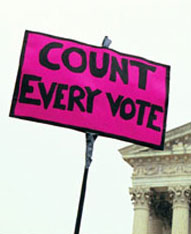Presidential Election Process Activity: Student Activity
Activity Overview
In this activity, you will examine the presidential election process established by the United States Constitution. You will then analyze the 2000 presidential election as a case study of this process.
Objectives
At the end of this activity, you will be able to:
- Describe the Electoral College process.
- Identify major events in the 2000 presidential election.
- Explain James Baker’s role in the 2000 presidential election.

Activity / Procedures
Part I: The Electoral College Process
The process of electing a U.S. president is based on the Electoral College. In this activity, you will argue to keep the Electoral College process the same or you will argue to reform the process. After you have a good understanding of the Electoral College process, you will examine the 2000 presidential election.
Your teacher will introduce the election process by showing you a video. If you need additional information about the Electoral College, you can view this clip from the National Archives to help you.
- After you have watched the video, explain the difference between the popular vote and the Electoral College vote.
-
In small groups, create a flow chart explaining the presidential election process. Use text and the Internet to conduct research. Make sure that your flow chart includes at least eight steps.
You can use the following Internet resources to get your started on your research:
Infographic: The Electoral College
Ben’s Guide to U.S. Government - Election of the President and Vice President: Electoral College
Part II: The 2000 Presidential Election
- The 2000 presidential election was the closest election since 1876 and only the fourth election in which the electoral vote did not reflect the popular vote. Watch this video clip about the 2000 election. After you have watched the clip, you will create a presentation explaining the major events of the 2000 election, with a focus on the Electoral College versus the popular vote; the recounts in Florida; James Baker’s role; and the Supreme Court case Bush v. Gore.
- Use the following resources to research more about the Bush v. Gore election.
Landmark Cases: Bush v. Gore
270 to Win: 2000 Presidential Election
2000 Events Timeline – Post Election
Election 2000 – C-Span Video - Create a presentation about the major events of the 2000 election. Your presentation may be a multimedia presentation such as PowerPoint, or Prezi, a news broadcast or an infographic. When you are finished, share your presentation with the class.
The 2000 Presidential Election Clip (from James Baker documentary)
Extension Activity
The 2000 election was not the only controversial election in U.S. history. The House of Representatives have had to decide several presidential elections. In other cases, the winner won the electoral votes but not the popular votes.
For this activity, you will examine several controversial elections, considering both the positive and negative aspects of the Electoral College. Then, you will take a position arguing for or against changes to the presidential election process.
Use the following resources to gather more information about controversial elections in U.S. history.
Resources
The Electoral College: Unusual Presidential Elections slideshow
Watch this brief slideshow to see highlights about three unusual elections, including the 1824 election between Jackson and Adams, the 1876 race between Hayes and Tiden, and the 1888 election between Harrison and Cleveland.
For even more information about these three contentious elections, check out the following websites:
- 1824 Presidential Election
- 1876 Presidential Election
- 1888 Presidential Election
- Carter-Baker Panel Calls for Voting Fixes
This 2005 article highlights a joint effort by former President Carter and James Baker to make significant changes in how Americans vote.

